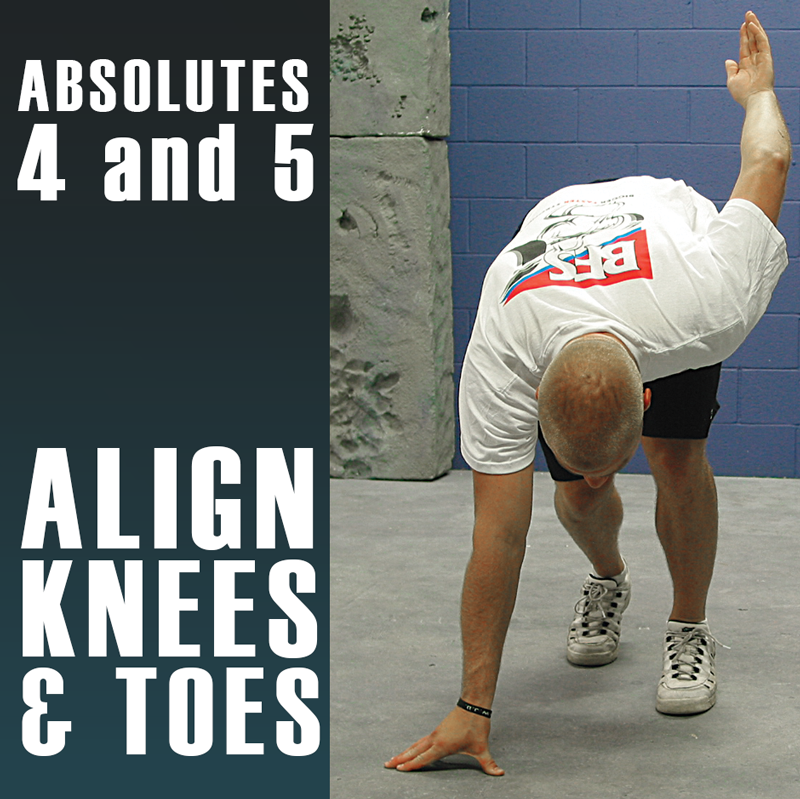Biomechanics of Injury Reduction!

The importance of knee and foot alignment for optimal performance - Absolutes 4 and 5
Originally published 2010
Coaches often comment on an athlete as having “good feet.” They want athletes who are light on their feet, are quick on their feet and have a fast “first step.” But having good feet is not a mysterious quality that only a few fortunate individuals are blessed with. Every athlete can improve this important athletic quality, much more than you might suspect.
Two of the most important absolutes for developing good feet are Absolute #4, align the toes; and Absolute #5, align the knees. Although these are considered separate absolutes, they work together. Before getting into the specifics of these two absolutes, let’s explore the importance of good lower body alignment for injury prevention and athletic performance.
The Numbers Game
Lower extremity injuries are one of the most common injuries in athletics, and in fact for the population as a whole. According to the National Center for Health Statistics, injuries to the feet, toes, and ankles accounted for 11 million visits to physicians’ offices in 2003, and 800,000 of those visits were diagnosed as ankle fractures. To make matters worse, as a study in Australia found, an athlete who injures an ankle is five times more likely to injure that ankle again. An ankle injury can cut short an athlete’s sports season and can lead to many more ankle injuries in the future.
It’s bad enough that ankle and foot injuries can stop athletes from participating in their sports, but often these injuries can lead to serious injuries to the knees and spine. Case in point: the ACL.
The ACL is a knee ligament that connects the lower and upper leg bones. It prevents the shins from moving excessively forward and prevents excessive rotation and angulation of the knee. The ACL can be injured when the knee is twisted, bent sideways or bent backward – and the risk of injury is higher if two or more of these actions occur at the same time.
Men and women are both susceptible to ACL injuries, but in sports such as volleyball, basketball, and soccer, it has been estimated that women can be up to eight times as likely as men to injure the ACL. One theory explaining this difference is that a woman’s wider pelvis changes the alignment of her lower extremities so that the upper thighs angle inward more than a man’s and therefore make the ACL weaker. Interestingly, about 70 percent of ACL injuries are from noncontact activities, which suggests that many of these injuries could be related to poor biomechanics.
Canadian posturologist and strength coach Paul Gagné said it well: “The feet and ankles are the foundation that the body is built upon; so if that foundation is weak, then everything above it is at risk.” An excellent way to strengthen that foundation is to focus on Absolutes #4 and #5.
Align the Toes
This may sound like simple common sense, but you should always strive to have an athlete’s toes “aligned.” What this means is that the toes should either be straight ahead (jump stance) or slightly pointed out for balance (athletic stance). We call this absolute toes aligned.
It’s important to consider that there are few activities in which the feet would be positioned perfectly straight ahead. Because of the way the upper thigh bone (femur) inserts into the hip, usually, there will be about five degrees of external rotation of the foot during many activities, such as squatting. And some individuals have what’s known as “open hips,” which makes it more natural for them to have the feet in a greater degree of external rotation. That’s fine. The idea is to avoid exaggeration – you don’t want your athletes waddling around with their feet out like Charlie Chaplin.
BFS Posters and More on sale with the BFS Summer Sale - Find More Here
Two exceptions that are often brought up about alignment of the toes are powerlifting squats and the postures of ballerinas. Although squatting with the feet pointed straight ahead is recommended by some powerlifting coaches, often the squats that are performed in their federations are not the deep squats that BFS recommends. These types of power squats are designed for specific powerlifting federations and for a specific purpose, which is to lift the most weight in the shortest distance. On the other extreme are ballet dancers, who are often required to perform movements with extreme “turnout” of the feet. For people with open hips, working to achieve these positions may not be an issue, but individuals with closed hips may find themselves at a high risk of lower extremity injuries, as it will be extremely difficult for them to achieve these postures.
A total strength and conditioning program involves, of course, a lot more than just lifting weights. It also involves stretching, jumping and sprinting. The toes also need to be aligned correctly in all of these phases of strength and conditioning.
It does not take very long for an athlete to experience dramatic improvements in technique using the toes aligned absolute. Insist that all athletes act as assistant coaches and always coach their teammates when spotting or performing any phase of strength and conditioning. If your goal is to win, then all athletes and coaches must be unified in helping each other become great.

Shown are three types of knee and foot alignment that can adversely affect athletic performance and increase the risk of injury.
Align the Knees
The knees must be positioned over the toes at all times in the weight room, in every phase of strength and conditioning, in every drill and in every athletic movement. We call this absolute knees aligned.
In sports or lifting, often the knees will be extremely forward of the toes. The athlete needs to learn to balance on the entire foot; the heels cannot come up. Be tall, spread the chest, eyes on target and sit with the hips well back. This will keep the knees aligned over the toes.
Knees that are in perfect alignment will be straight from every position. A good test is to take a ruler and place the top end at the middle of an athlete’s knee and let it hang perpendicular to the ground. The bottom of the ruler should be at the middle of the athlete’s toes, specifically the long toe. If the ruler is inside or outside, the position is incorrect. Sometimes the knees will be outside the toes. This is almost always due to a narrow stance. Simply widen the stance to resolve this problem.
Shown are three types of knee and foot alignment that can adversely affect athletic performance and increase the risk of injury.
Having improper knee alignment is a common problem in squatting. Sometimes beginning athletes squat with their knees too far forward, with the heels off the ground. This posture puts too much pressure on the patella (i.e., kneecap) area, besides being absolutely ineffective. If the knees are past the tips of the toes, they are too far forward. To help correct this, use the partner system and practice squatting with the hips back and the knees vertical, as straight as possible. Another great way to learn how to balance is to try a front squat with a very light weight. This will help an athlete practice the art of stabilizing his or her body
correctly.
Download the Free 6 Absolutes Book
Squatting with the knees excessively pointed out will put undesirable pressure on the lateral collateral ligaments (located on the outside of the knee). The knees-out problem is easy to correct: simply widen the athlete’s stance until the knees are aligned directly over the toes.
The most common problem is that athletes allow their knees to come together excessively when they squat, putting pressure on the medial collateral ligament (located on the inside of the knee). Although as an individual rises from the squat, there will usually be some slight inward movement by the knees, this is natural – it’s when you see an extreme buckling of the knees that it becomes a problem that must be addressed.
The knees-in problem is more difficult to correct than knees-out. The first step is to say “knees” to athletes while they are squatting or doing some other lift. This is a signal to force the knees out over the toes. This signal may or may not work the first time. If not, a second corrective technique is to lightly tap the inside of the athlete’s knee. This kinesthetic approach gives the athlete an actual feel for the problem. The cure usually happens after only a few light taps. If the problem persists, then videotape the athlete so that he or she can see the problem. This combination of coaching guidelines will almost always do the trick.
Remember, you can use this same absolute when coaching any activity: running, jumping, stretching or in sports practice. Your athletes will perform better in all these areas and will be less susceptible to injuries if they keep their toes aligned and knees aligned.
See videos on all the Six Absolutes HERE
See A Closer Look at Absolute #1 Here
See A Closer Look at Absolute #2 Here
See A Closer Look at Absolute #3 Here

